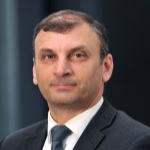
Maysam Abbod
Work place: Department of Electronic and Computer Engineering, School of Engineering, Design and Physical Science, Brunel University London, UK
E-mail: maysam.abbod@brunel.ac.uk
Website:
Research Interests: Computational Science and Engineering, Computer systems and computational processes, Data Structures and Algorithms, Combinatorial Optimization
Biography
Maysam Abbod received the Ph.D. degree in control engineering from The University of Sheffield, U.K., in 1992. He is currently a Reader 919 of electronic systems with the Department of Electronic and Computer Engineering, Brunel University London, UK. He has authored more than 50 papers in journals, nine chapters in edited books and more than 50 papers in refereed conferences. His current research interests include 925 intelligent systems for modeling and optimization. He is a member of the IET, UK, and a Chartered Engineer in U.K. He is serving as an Associate Editor for the Engineering Application of Artificial Intelligence Elsevier.
Author Articles
Helicopter Control Using Fuzzy Logic and Narma-L2 Techniques
By Noor Salam Al-Fallooji Maysam Abbod
DOI: https://doi.org/10.5815/ijisa.2020.05.01, Pub. Date: 8 Oct. 2020
Helicopter instability is one of the most limitations that should be addressed in a nonlinear application. Accordingly, researchers are invited to design a robust and reliable controller to obtain a stable system and enhance its overall performance. The present study focuses on the use of the intelligent system in controlling the pitch and yaw angles. This lead to controlling the elevation and the direction of the helicopter. Further to the application of the Linear Quadratic Regulator (LQR) controller, this research implemented the Proportional Integral Derivative (PID), Fuzzy Logic Control (FLC), and Artificial Neural Network (ANN). The results show that FLC achieved a good controllability for both angles, particularly for the pitch angle in comparison to the nonlinear auto regressive moving average (NARMA-L2). Moreover, NARMA-L2 requires further improvement by using, for example, the swarm optimization method to provide better controllability. The PID controller, on the other hand, had a greater capability in controlling the yaw angle in comparison to the other controllers implemented. Accordingly, it is suggested that the integration of PID and FLC may lead to more optimal outcomes.
[...] Read more.Modelling Oil Pipelines Grid: Neuro-fuzzy Supervision System
By Nagham H. Saeed Maysam Abbod
DOI: https://doi.org/10.5815/ijisa.2017.10.01, Pub. Date: 8 Oct. 2017
One of the major challenges for researchers and governments across the world is reducing resources-waste or loss. Resources loss can happen if there is not a capable control system that contributes to environmental change. The specific aim is to create user-friendly control and monitoring system to reduce the waste in resources. New Artificial intelligence techniques have been introduced to play an important part in developing such systems.
In oilfields, the oil is extracted then distributed via oil pipes until it reaches the end consumer. This operation will occur without a full and complete monitoring for the oil in the pipeline’s journey to the provider. Although, the existing oilfield monitoring systems can communicate locally but they will not send information back to the main provider. That means the provider is not aware of the whole circumstances happened in the transportation process. That gives the provider no control on the process. For example, a sudden decision from the main provider to stop transporting to a specific destination or knowing where the leakage is and which pipe is leaking in the pipelines grid.
This paper, introduces for the first-time oilfield pipeline Neuro-fuzzy (NF) supervision system using Simscape simulation software package. This system can be the first step solution to keep real time communication between the main provider and the oil transportation process in the oilfields and enables the provider to have full supervision on the oil pipes grid. The simulation supervision system illustrates a clear real-time oilfield pipeline grid that gives the provider the ability to control and monitor pipeline grid and prioritise the recovering process. The two parameters selected for control and monitoring were volume and pressure. The results in this paper show full control for the NF supervision system on the transportation process.
Other Articles
Subscribe to receive issue release notifications and newsletters from MECS Press journals